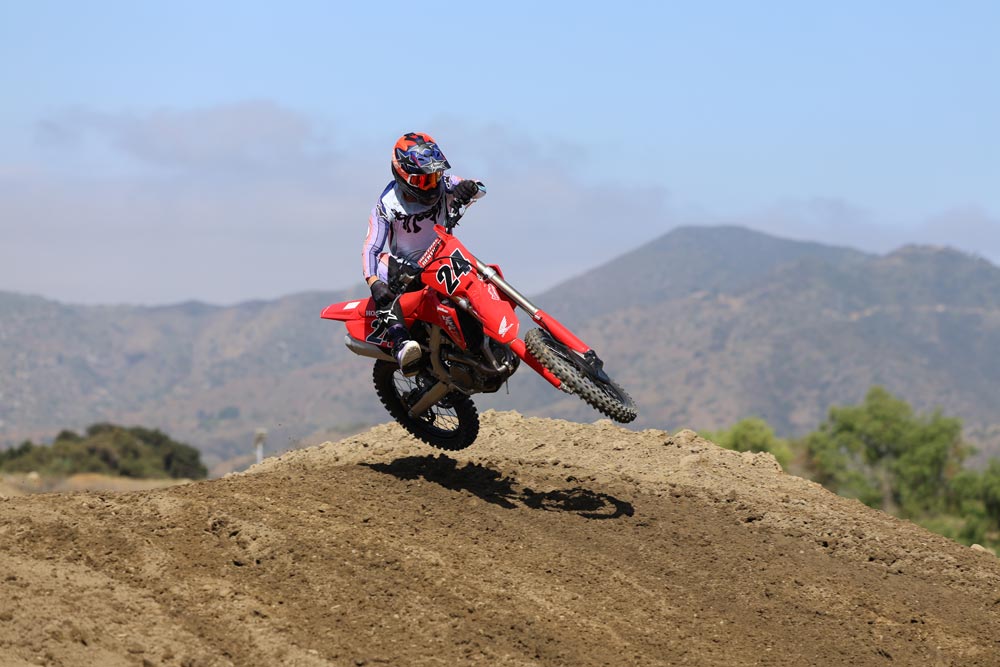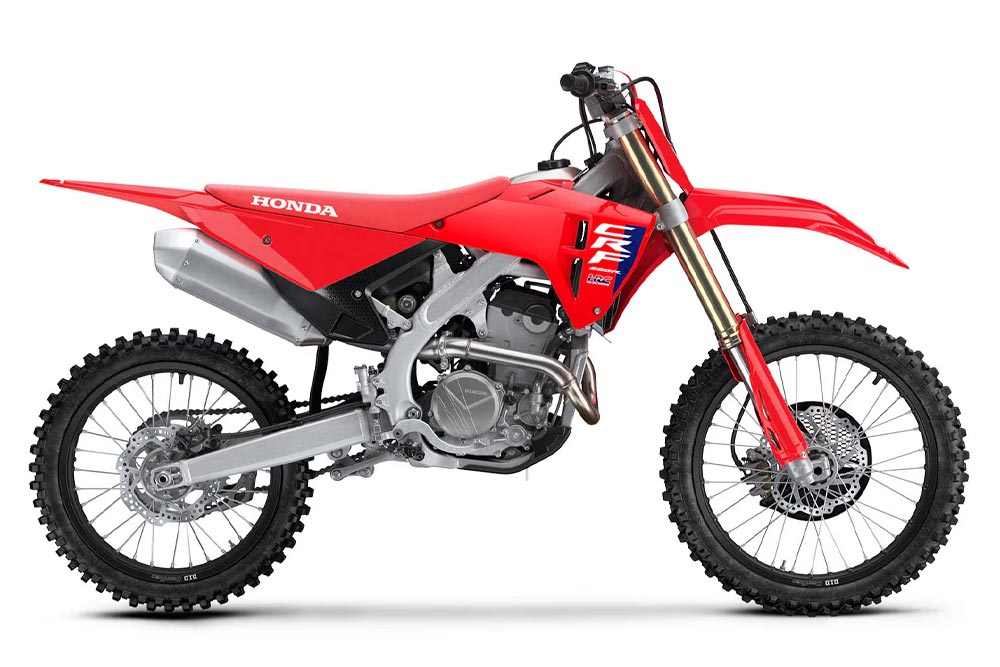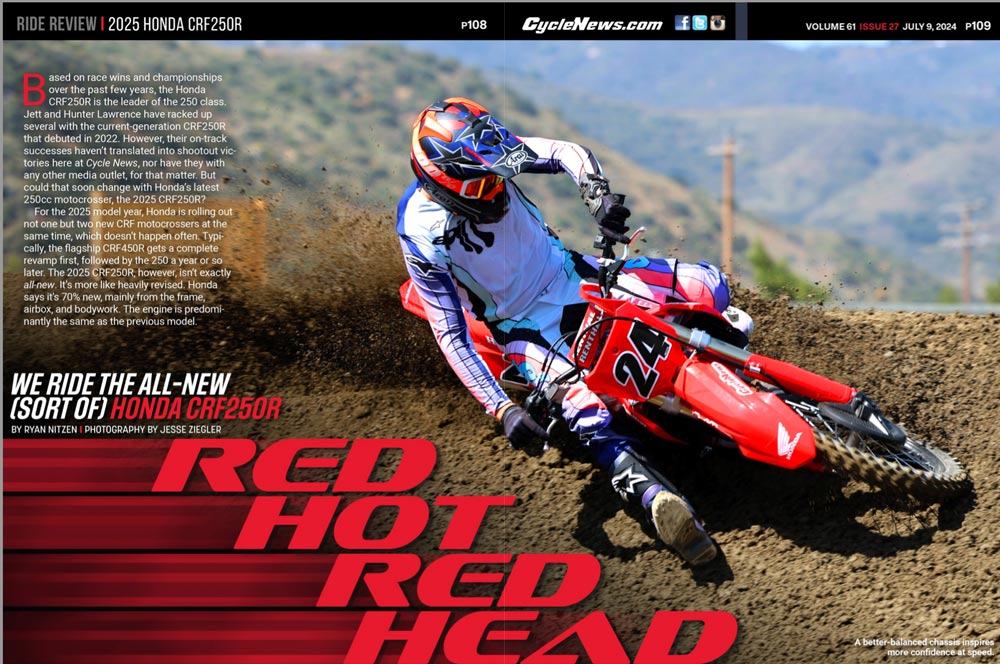Based on race wins and championships over the past few years, the Honda CRF250R is the leader of the 250 class. Jett and Hunter Lawrence have racked up several with the current-generation CRF250R that debuted in 2022. However, their on-track successes haven’t translated into shootout victories here at Cycle News, nor have they with any other media outlet, for that matter. But could that soon change with Honda’s latest 250cc motocrosser, the 2025 CRF250R?

Photography by Jesse Ziegler
For the 2025 model year, Honda is rolling out not one but two new CRF motocrossers at the same time, which doesn’t happen often. Typically, the flagship CRF450R gets a complete revamp first, followed by the 250 a year or so later. The 2025 CRF250R, however, isn’t exactly all-new. It’s more like heavily revised. Honda says it’s 70% new, mainly from the frame, airbox, and bodywork. The engine is predominantly the same as the previous model.
We first laid eyes on both new red rides a few weeks ago at the Fox Raceway National. At the launch party, we sat down with Honda HRC test rider and former 250 champ Trey Canard to get the inside scoop on new changes to the CRF lineup. He explained that despite feeling stiff in the rider’s hands, the current CRF250R actually offers one of the softest aluminum frames on the market. The flexy nature of the frame can bend and twist under load, which in turn upsets the suspension before reacting back in the opposite direction. During our testing, we’d often soften the suspension because the bike felt so ultra-stiff, but the clicker adjusters weren’t enough to solve our complaints. Canard reiterated what we felt was the forgiving frame overworking in the rough conditions. These feelings were common among test riders and provided context into the updates for the 2025 models.

So how did the same bike that finished at the back of our shootouts win both the Supercross and Pro Motocross titles? Looking at Jett and Hunter Lawrence’s Honda frames, it’s easy to spot the differences in areas where material was added to stiffen the frame and reduce the flex of the stock bike. The main point of contention was the head and down tube connections, as extra welds and reinforcements were added to this crucial area. AMA rules only allow teams to add material, not take away, so these additions are legal and offer the team real-life data on improving the handling of their next-gen machines. The same areas where material was visibly added on the factory bikes now sport a clean OEM look on the 2025 frames.


Other obvious changes to the ‘25 250 include new triple clamps and front axle to harmonize with the updated frame and fork. According to Honda, a new rear shock mount makes shock removal 50 percent easier than before. A new subframe and body panels cover up the new airbox, which features 78 percent more capacity than before and a straighter down-draft intake designed to help move air through the engine with better efficiency. Pair that with a lighter crank and updated gear ratios for a high-revving race bike. Honda also outfitted the bike with a new electronics cluster, the same one featured on the 450R. This three-button unit features three maps—standard, smooth, and aggressive—as well as traction and launch control.

I was still skeptical when Honda’s main talking point about this bike was making it “stiffer” and “more rigid.” The previous bike felt like riding a two-by-four! They invited us to Fox Raceway for our first shakedown of the new CRF250R

Right away, the bike feels similar to the current-gen Honda CRF250R. The seat, bars, pegs, and overall rider cockpit are super-neutral and feel classic Honda. This is a plus for riders who jump from a ’22-’24 to a ’25 since the difference is less drastic than something like the ’23 versus ’24 Yamaha YZ250F. The Honda shrouds are just a bit wider than before, but not enough to be a nuisance when riding. Instead, they work as leverage for your knees when cornering. The bike’s rear end also feels symmetrical, with new textured side panels for added leg grip. I’m not a huge fan of the retro-looking shrouds, but overall, the body’s functionality hits the mark in my book.


The engine is another strong suit for the new CRF. The previous Honda 250 had a high-strung personality that needed to be revved to the moon to go anywhere. You had to ride it like a 125 two-stroke, carrying momentum without relying on the minimal low end. The new airbox, exhaust, and gear ratios give it noticeably more torque off the bottom while still keeping that high-revving personality as before. The added grunt allows you to pop out of the inside ruts with less effort and seat bounce a jump with a short run-up. The aggressive setting was my go-to, offering the best blend of an initial hit and a long-pulling mid-to-top range.
Gears two and three felt noticeably longer, and the bike wasn’t begging you to shift it as often as before. I didn’t play with the traction control settings due to the primo conditions of our track day, but it’s a nice addition, especially since it brings it up to par with the other bikes in the class. Overall, the engine felt throatier and just plain stronger than I remember without losing that top-end over-rev synonymous with the current breed of 250 four-strokes.

“Precise” is the first word that comes to mind when describing the Honda’s new chassis. The previous-generation bike required so much input to get a clean corner as the bike fought the rider from front to back and side to side. Now, it feels planted and much more predictable. You can point and shoot, feeling confident that the bike will end up in your chosen line. This feeling was apparent in braking bumps and corner entry zones, as it required less rider input to coerce the bike in and through the turn. At speed, the bike felt stable and tracked in a straight line.

The suspension played a crucial role in the handling, as the fork and shock did their job in smooth harmony. The fork held up in the stroke and easily absorbed small bumps while taking big hits in stride. The 49mm Showa sticks feel much plusher than before and work well in all areas of the travel, not just up top or down low. Most notable was the reduction of vibrations sent into the rider’s hands. The shock also felt planted under power. Its motion was much less pitchy and didn’t kick around like I remembered. This gives a comfortable feel on jump landings and when taking a sweeping outside line. Finally, the CRF feels like something other than a stiff plywood board.

Engineering a well-balanced motorcycle is intriguing, and after riding the new CRF250R, Trey Canard’s logic of going stiffer to make the bike softer finally made sense. By stiffening key areas of the frame and fork, they’ve allowed each part to work as it’s supposed to rather than bend, flex, and react upon impact. The bike is now much more predictable and easier to ride. Pair that with a stronger engine and more electronics, and you’ve got a well-rounded machine with its sights set on the top step of the podium for both racers and regular consumers.CN
VIDEO | First Look: 2025 Honda CRF250R
VIDEO | 2025 Honda CRF250R Ride Review

2025 Honda CRF250R Specifications
| MSRP | $8299 |
| Engine Type | 4-stroke, single |
| Displacement | 249.9cc, DOHC |
| Bore x Stroke | 79.0 x 50.9mm |
| Compression Ratio | 13.9:1 |
| Cooling System | Liquid |
| Starting System | Electric |
| Fueling | Fuel Injection with 44mm throttle bore |
| Transmission | 5-speed, cable clutch |
| Frame | Aluminum |
| Front Suspension | 49mm Showa SPG coil-spring fork |
| Rear Suspension | Pro-Link Showa single shock |
| Front-Wheel Travel | 12.2 in. |
| Rear-Wheel Travel | 12.1 in. |
| Front Wheel | 21 in. |
| Rear Wheel | 19 in. |
| Front Tire | Pirelli Scorpion MX32; 80/100-21 in. |
| Rear Tire | Pirelli Scorpion MX32; 100/90-19 in. |
| Final Drive | 13/50, chain |
| Front Brake | Single 260mm disc |
| Rear Brake | Single 240mm disc |
| Seat Height | 37.76 in. |
| Ground Clearance | 13 in. |
| Fuel Capacity | 1.7 gal. |
| Wheelbase | 58.4 in. |
| Weight (claimed) | 234 lbs |

Click here to read the 2025 Honda CRF250R Review in the Cycle News Digital Edition Magazine.
Click here for the latest Cycle News Motocross bike reviews and news.
Click here for more Honda motorcycle reviews and news.
